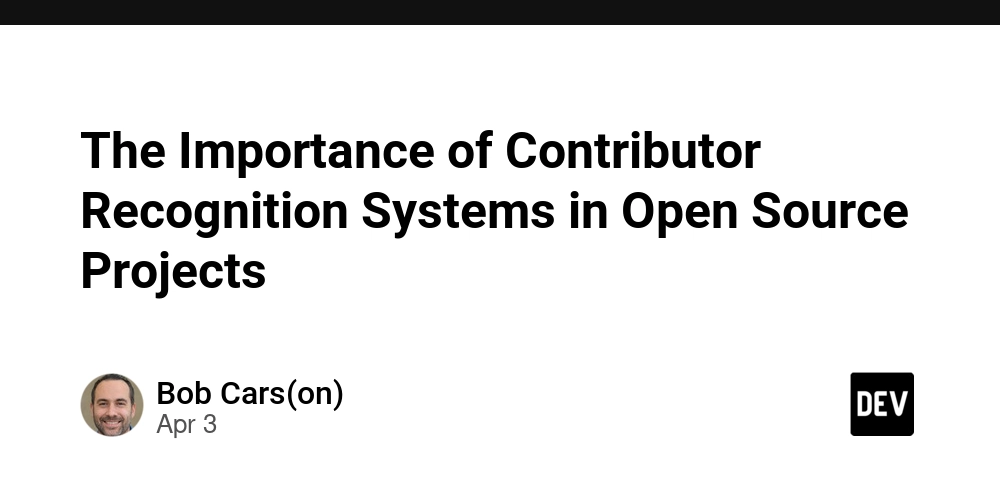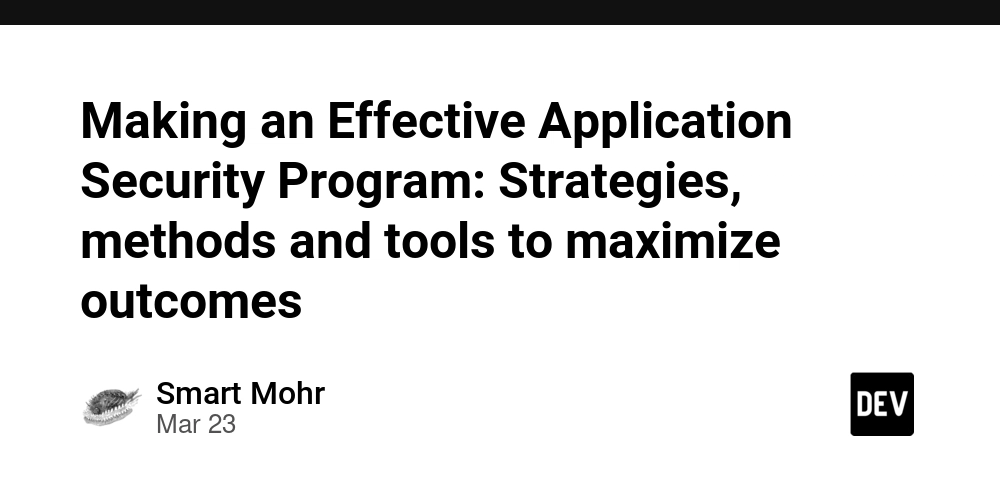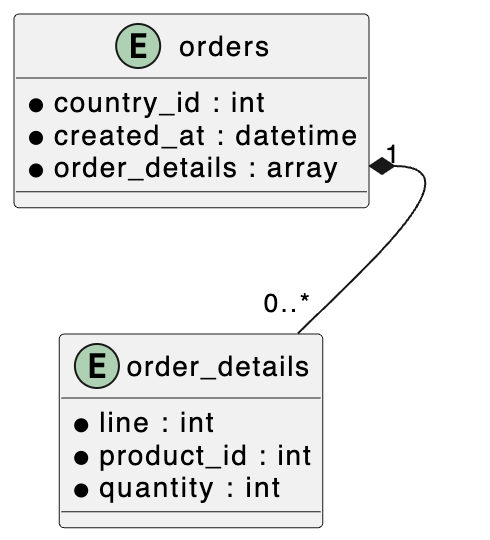The Importance of Contributor Recognition Systems in Open Source Projects
Abstract This post explores the central role of Contributor Recognition Systems (CRS) in open source projects, detailing the benefits of such systems in fostering vibrant communities, enhancing quality contributions, and ensuring project sustainability. Drawing from expert insights and diverse sources—including release notes guidance, community motivation strategies, and trends in ethical software development—the article examines the evolution of open source funding and governance. Tables, bullet lists, and embedded links to authoritative sources offer a comprehensive yet accessible resource for developers, project maintainers, and technology enthusiasts alike. Introduction Open source projects rely on passionate contributions from volunteers and professionals who share their skills to build innovative software. A well-crafted Contributor Recognition System (CRS) is a strategic tool that not only rewards these contributions but also nurtures a thriving community. In today’s fast-changing tech landscape, recognition systems offer an effective means for projects to sustain quality, encourage inclusivity, and promote ethical practices. This post discusses the importance of CRS, its core features, practical applications, challenges, future outlook, and how it aligns with the broader ecosystem of open source development. Background and Context The concept of recognizing contributors is not new; however, with the rise of community-driven projects and decentralized development, the discussion has gained unprecedented relevance. Historically, many developers engaged in unpaid volunteer work—a fact underscored by research on unpaid volunteer work—often without any structured acknowledgment. Today, CRS tools allow projects to publicize contributions in various formats, from showcasing in release notes to awarding digital badges and other tokens of appreciation. Open source ecosystems emphasize transparency, sustainability, and inclusivity. For instance, projects that embrace community-driven initiatives not only retain talent but also enhance collaboration and trust among contributors. This culture of recognition is further bolstered by ethical frameworks, as discussed in guides on ethical software development. Several key background themes have emerged over the years: Motivation and Empowerment: Formal systems that document contributions and reward quality help steer both existing and new contributors. Community Inclusivity: Recognizing value beyond code fosters a broader participation that includes documentation writers, designers, and community managers. Quality and Metrics: Utilizing quantifiable metrics, such as those from metrics that matter for software quality, helps ensure that contributions meet high standards. Core Concepts and Features A robust contributor recognition system includes several interrelated features: 1. Public Acknowledgment and Visibility Publicly acknowledging contributors not only motivates them but also increases their professional visibility. Digital Badges and Certificates: These are often awarded based on defined contributions and served as markers of excellence. Release Note Mentions: Projects frequently highlight notable contributions in release notes, an approach discussed in this guide on contributing. 2. Community and Inclusivity CRS frameworks must be inclusive to address diverse contributions: Broad Scope of Contributions: Recognizing work done in coding is essential, but contributions in documentation, design, and community engagement should also be acknowledged. Diverse Recognition: As highlighted at Making Your Open Source Project Diverse and Inclusive, a variety of contributions ensure a more balanced ecosystem. 3. Quality, Metrics, and Analytics Maintaining project quality requires robust measurement of contributions: Analytic Tools: Systems, such as FOSS contributor analytics, can track contributions over time. Quantitative Metrics: Utilizing code quality metrics and innovation metrics ensures that recognized contributions meet high standards, supporting improved project outcomes. 4. Sustainability and Risk Management A well-functioning CRS boosts both immediate morale and long-term sustainability: Project Sustainability: As detailed in software sustainability, consistent and transparent recognition helps secure ongoing project success. Risk Management: Integrated strategies assist in mitigating risks by recognizing and validating contributions early, ultimately reducing conflicts. Table: Key Features of a Robust CRS Feature Description Benefit Public Acknowledgment Visibility through release notes, badges, and certificates Increases motivation and professional image Inclusivity Acknowledgment of non-code contributions such as design and documentation Enhances community diversity and collaboration Quality Me

Abstract
This post explores the central role of Contributor Recognition Systems (CRS) in open source projects, detailing the benefits of such systems in fostering vibrant communities, enhancing quality contributions, and ensuring project sustainability. Drawing from expert insights and diverse sources—including release notes guidance, community motivation strategies, and trends in ethical software development—the article examines the evolution of open source funding and governance. Tables, bullet lists, and embedded links to authoritative sources offer a comprehensive yet accessible resource for developers, project maintainers, and technology enthusiasts alike.
Introduction
Open source projects rely on passionate contributions from volunteers and professionals who share their skills to build innovative software. A well-crafted Contributor Recognition System (CRS) is a strategic tool that not only rewards these contributions but also nurtures a thriving community. In today’s fast-changing tech landscape, recognition systems offer an effective means for projects to sustain quality, encourage inclusivity, and promote ethical practices. This post discusses the importance of CRS, its core features, practical applications, challenges, future outlook, and how it aligns with the broader ecosystem of open source development.
Background and Context
The concept of recognizing contributors is not new; however, with the rise of community-driven projects and decentralized development, the discussion has gained unprecedented relevance.
Historically, many developers engaged in unpaid volunteer work—a fact underscored by research on unpaid volunteer work—often without any structured acknowledgment. Today, CRS tools allow projects to publicize contributions in various formats, from showcasing in release notes to awarding digital badges and other tokens of appreciation.
Open source ecosystems emphasize transparency, sustainability, and inclusivity. For instance, projects that embrace community-driven initiatives not only retain talent but also enhance collaboration and trust among contributors. This culture of recognition is further bolstered by ethical frameworks, as discussed in guides on ethical software development.
Several key background themes have emerged over the years:
- Motivation and Empowerment: Formal systems that document contributions and reward quality help steer both existing and new contributors.
- Community Inclusivity: Recognizing value beyond code fosters a broader participation that includes documentation writers, designers, and community managers.
- Quality and Metrics: Utilizing quantifiable metrics, such as those from metrics that matter for software quality, helps ensure that contributions meet high standards.
Core Concepts and Features
A robust contributor recognition system includes several interrelated features:
1. Public Acknowledgment and Visibility
Publicly acknowledging contributors not only motivates them but also increases their professional visibility.
- Digital Badges and Certificates: These are often awarded based on defined contributions and served as markers of excellence.
- Release Note Mentions: Projects frequently highlight notable contributions in release notes, an approach discussed in this guide on contributing.
2. Community and Inclusivity
CRS frameworks must be inclusive to address diverse contributions:
- Broad Scope of Contributions: Recognizing work done in coding is essential, but contributions in documentation, design, and community engagement should also be acknowledged.
- Diverse Recognition: As highlighted at Making Your Open Source Project Diverse and Inclusive, a variety of contributions ensure a more balanced ecosystem.
3. Quality, Metrics, and Analytics
Maintaining project quality requires robust measurement of contributions:
- Analytic Tools: Systems, such as FOSS contributor analytics, can track contributions over time.
- Quantitative Metrics: Utilizing code quality metrics and innovation metrics ensures that recognized contributions meet high standards, supporting improved project outcomes.
4. Sustainability and Risk Management
A well-functioning CRS boosts both immediate morale and long-term sustainability:
- Project Sustainability: As detailed in software sustainability, consistent and transparent recognition helps secure ongoing project success.
- Risk Management: Integrated strategies assist in mitigating risks by recognizing and validating contributions early, ultimately reducing conflicts.
Table: Key Features of a Robust CRS
| Feature | Description | Benefit |
|---|---|---|
| Public Acknowledgment | Visibility through release notes, badges, and certificates | Increases motivation and professional image |
| Inclusivity | Acknowledgment of non-code contributions such as design and documentation | Enhances community diversity and collaboration |
| Quality Metrics | Tracking performance using code quality metrics and project analytics | Maintains high standards and reduces technical risk |
| Sustainability Strategies | Integration with risk management and funding models | Secures long-term project viability |
| Blockchain and AI Integration | Future systems leveraging AI for personalization and blockchain for immutability in recognition | Ensures decentralized and tamper-proof rewards |
5. Integration with Emerging Technologies
Modern CRS tools also explore the incorporation of technologies such as blockchain and AI. These enable:
- Immutable Records: Blockchain can record contributions permanently, ensuring fair acknowledgment.
- Personalized Recognition: AI can tailor recognition based on individual contributor history. Access further insights into emerging trends in open source at Future of Open Source.
Applications and Use Cases
CRS systems have broad practical applications for both individual projects and large open source communities. Here are a few examples:
Example 1: Developer Communities on GitHub
GitHub projects increasingly use platforms like GitHub Sponsors to track and appreciate contributions. Listing contributor names in release notes and awarding monthly badges fosters accountability and community spirit.Example 2: Documentation-Driven Projects
Projects that rely heavily on documentation, tutorials, and translation efforts benefit significantly when every role is publicized. This approach boosts morale in scenarios where code contributions are only the tip of the iceberg, creating an inclusive environment as illustrated in guides on diverse open source projects.Example 3: Blockchain-Integrated Projects
With the integration of blockchain for secure and transparent records, CRS systems become crucial in managing decentralized contributions. Innovative funding models and contributor tokens are being explored as a way to maintain the integrity of contributions. Projects at the intersection of open source and blockchain, such as those referenced in Arbitrum and Cross-chain Bridging articles, show promise in this arena.
Bullet List: Advantages of a Well-Implemented CRS
- Boosts Contributor Morale: Public recognition fuels motivation.
- Encourages Continuous Contribution: Contributors are incentivized to maintain high-quality work.
- Promotes Transparency: Open acknowledgment practices lead to broader community trust.
- Enhances Project Sustainability: Consistent recognition drives long-term adherence and growth.
- Facilitates Inclusive Innovation: Recognizes diverse forms of action beyond just coding.
Challenges and Limitations
While the benefits are significant, several technical and social challenges need to be addressed:
Technical Challenges
- Data Integration: Combining various contribution metrics into a seamless reporting system can be complex.
- Scalability: As projects grow, systems must scale accordingly while maintaining performance and transparency.
- Blockchain and AI Integration Hurdles: While promising, the integration of blockchain for immutable records and AI for personalized feedback may encounter technical and security issues.
Social and Adoption Challenges
- Contributor Diversity: Ensuring that all contributions—both visible and behind the scenes—are fairly recognized can be difficult when the focus is predominantly on code quality.
- Bias in Recognition: Existing metrics may sometimes favor established contributors over newcomers, potentially undermining inclusivity.
- Funding and Resource Allocation: Even with recognition, many open source contributions remain unpaid. Balancing volunteer contributions with professional rewards is an ongoing challenge as discussed in open source developer funding challenges.
Future Outlook and Innovations
The future of CRS is intertwined with evolving technologies and the changing nature of open source contributions. Here are some key trends to watch:
- Blockchain for Immutable Recognition: Projects are exploring blockchain to create tamper-proof records of contribution. These systems have the potential to revolutionize how contributions are recorded and validated.
- AI-Powered Analytics: Artificial Intelligence will further personalize recognition by analyzing not only quantity but the quality and impact of contributions over time.
- Integration with Funding Models: Future fiscal models, including innovative sponsorships and open source sponsorship, will interlace gratitude with financial reward. For additional perspectives on funding innovations, refer to Exploring IBM Public License 10 RV.
- Enhanced Community Engagement: Continued efforts to weave in community engagement strategies and risk management approaches will further enhance the sustainability and growth of open source projects. Innovative initiatives such as those outlined in Navigating Fair Code Licenses also indicate a future where funding, recognition, and compliance all merge into a cohesive ecosystem.
Summary
In conclusion, a well-implemented Contributor Recognition System is essential for fostering an engaged and thriving open source community. By acknowledging the full spectrum of contributions—from code to community engagement—CRS not only boosts morale but also enhances transparency, sustainability, and overall project quality. As open source projects evolve, leveraging emerging technologies like blockchain and AI will further refine these systems. This evolution will pave the way for comprehensive and fair funding models, as seen in organizations that successfully integrate GitHub Sponsors and other innovative models.
The key takeaways include:
- Public Recognition and Incentives: Critical for motivation and continuous contributions.
- Inclusivity: Recognizing diverse contributions enhances community growth and diversity.
- Data and Metrics: Use analytic tools and quality metrics to maintain high standards.
- Challenges Remain: From scalability and data integration to balancing volunteer work with paid contributions.
- Future Trends: Blockchain and AI integration promise a more transparent, efficient, and engaging CRS.
For developers, maintainers, and open source enthusiasts, investing time and resources into building a robust CRS is not just about giving credit—it’s about securing long-term project success and fostering a culture of collaboration, innovation, and trust.
Further reading:
- Explore more about contributions and sustainability at open source contributors' motivation.
- Learn about the intricacies of volunteer contributions on projects by visiting this overview on unpaid volunteer work.
- To get a broader perspective on the sustainable funding for open source, check out insights on software sustainability.
By embracing these practices, open source projects can ensure that contributors feel truly valued and remain motivated to continue their invaluable work—keeping the spirit of collaboration and innovation alive in every repository, community forum, and global development initiative.
Overall, Contributor Recognition Systems have transformed the landscape of open source, ensuring that every piece of effort is recognized and celebrated. With the integration of emerging technology trends and evolving community funding models, the future of open source looks brighter than ever.










































































































































































![[The AI Show Episode 142]: ChatGPT’s New Image Generator, Studio Ghibli Craze and Backlash, Gemini 2.5, OpenAI Academy, 4o Updates, Vibe Marketing & xAI Acquires X](https://www.marketingaiinstitute.com/hubfs/ep%20142%20cover.png)



























































































































![[FREE EBOOKS] The Kubernetes Bible, The Ultimate Linux Shell Scripting Guide & Four More Best Selling Titles](https://www.javacodegeeks.com/wp-content/uploads/2012/12/jcg-logo.jpg)



![From drop-out to software architect with Jason Lengstorf [Podcast #167]](https://cdn.hashnode.com/res/hashnode/image/upload/v1743796461357/f3d19cd7-e6f5-4d7c-8bfc-eb974bc8da68.png?#)






































































































.png?#)




.jpg?#)































_Christophe_Coat_Alamy.jpg?#)








































































































![Rapidus in Talks With Apple as It Accelerates Toward 2nm Chip Production [Report]](https://www.iclarified.com/images/news/96937/96937/96937-640.jpg)









































































































































